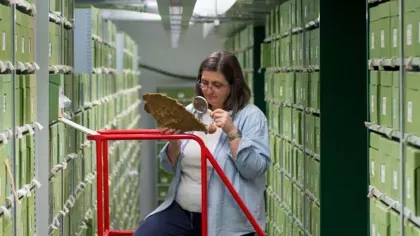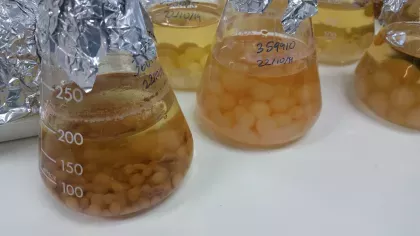Sequencing Kew's Fungarium
We're sequencing the DNA of thousands of fungi to accelerate global research in fungal diversity, taxonomy, and evolution.

We're collaborating with the Natural History Museum (NHM) and Royal Botanic Garden Edinburgh (RBGE) on a groundbreaking research initiative to sequence the DNA of our world-renowned collections of fungi and lichens.
This project is transforming our understanding of fungal and lichen diversity, ecology and evolution with potential applications in medicine, agriculture, and environmental restoration.
Unlocking genetic secrets – fungi museomics
Dried fungi and lichen collections at Kew, NHM and RBGE are the largest of their kind, housing around two million specimens in total. By sequencing their DNA, we're enabling researchers to:
- Identify and classify unknown species
- Monitor biodiversity and ecosystem changes
- Develop tools to detect fungal biosecurity threats

Why is this important?
Fungi and lichens play a critical role in maintaining ecosystems, recycling nutrients, and sequestering carbon. Lichens are vital indicators of air quality and ecosystem health. Fungi are also part of products and processes that we rely heavily on in all aspects of everyday life, from critical drugs to synthesis of biofuels, to cleaning up the environment through bioremediation.
Conversely, fungal infections kill over 1.6 million people annually, more than malaria or breast cancer. Critically for food security, fungal plant pathogens destroy up to 30% of global crop products, enough food annually to feed 600 million people. Despite their importance, fungi have been historically under-researched compared with plants and animals.
Of an estimated 2.5 million fungal species, only 155,000 have been identified and named, largely using morphological criteria that are in many cases inexact, impeding our ability to interpret environmental data and identify useful biomolecules. Plugging this gap in foundational knowledge by using DNA methods promises unparalleled benefits for society and economic growth.
This research forms part of a broader alliance between Kew, NHM, and University College London to safeguard biodiversity. Together, our aim is to address global challenges, from biodiversity loss to climate change, in alignment with international frameworks like the Kunming-Montreal Global Biodiversity Framework and the UN Sustainable Development Goals.
Dr Ester Gaya, Senior Mycologist at Kew, emphasises the transformative potential of this project in characterizing fungal diversity.
Dr Mark Carine, Principal Curator at NHM, highlights the role of genomics in understanding biodiversity and ecosystem functions.
Dr Rebecca Yahr, Lichenologist at RBGE.
This project is funded by:
- Defra
- Calleva Foundation
Help Kew unlock the secrets of fungi and lichens
Donations to this project help decode the DNA of fungi and lichens to unlock breakthroughs in medicine, agriculture, and environmental restoration.
Get in touch with our major donations team to learn more: a.arango@kew.org




.jpg.webp?itok=HveKzBI-)